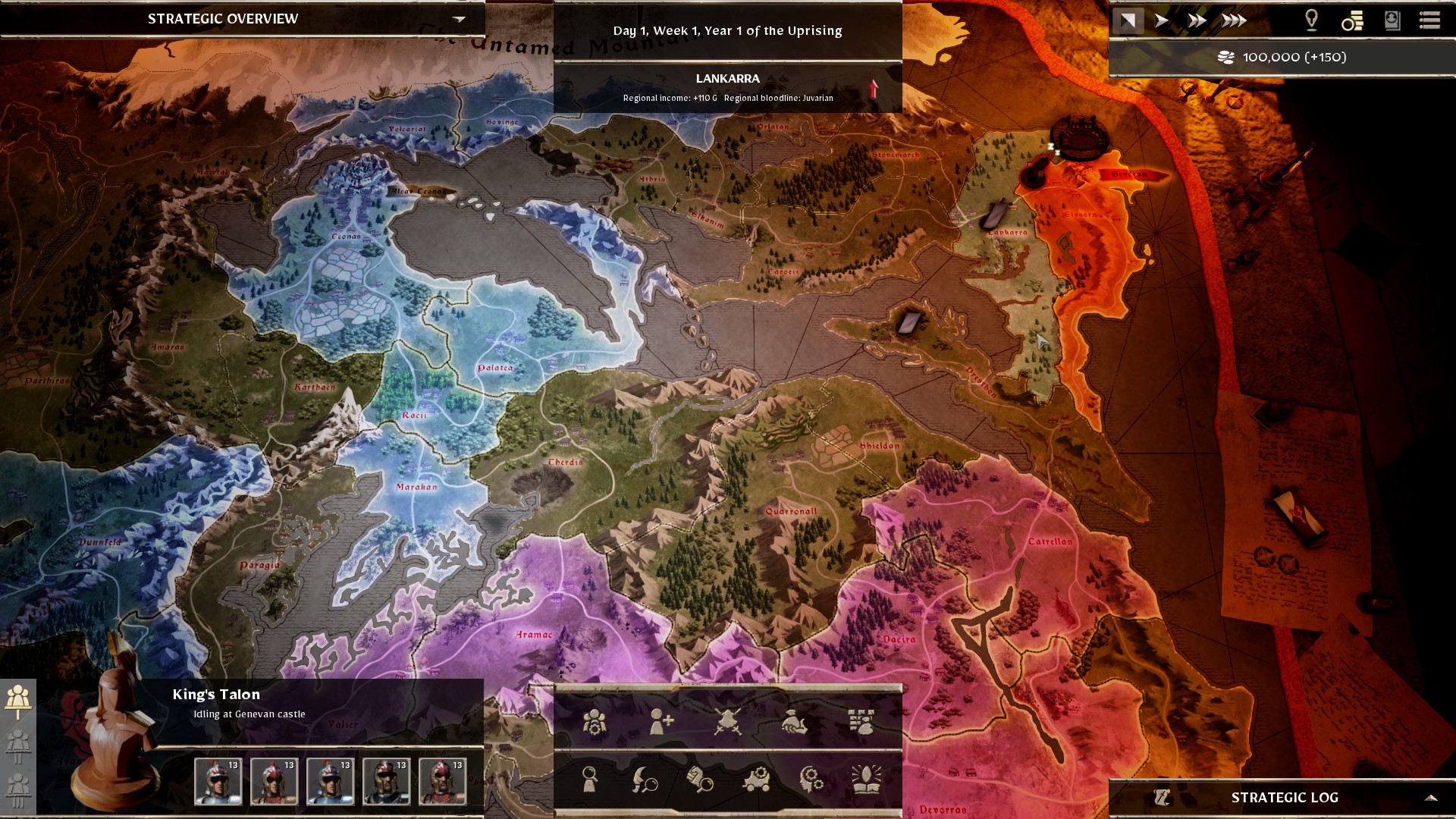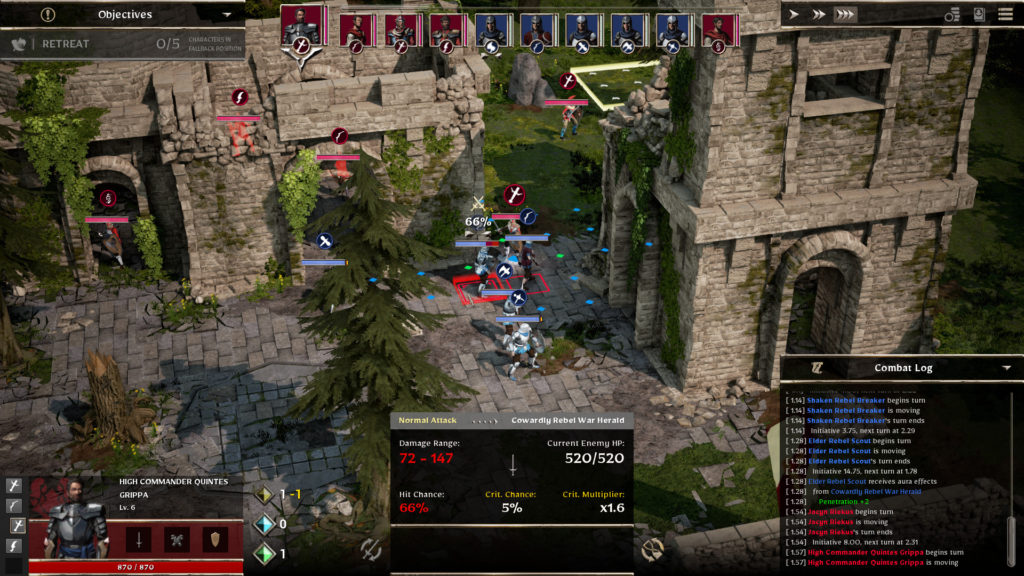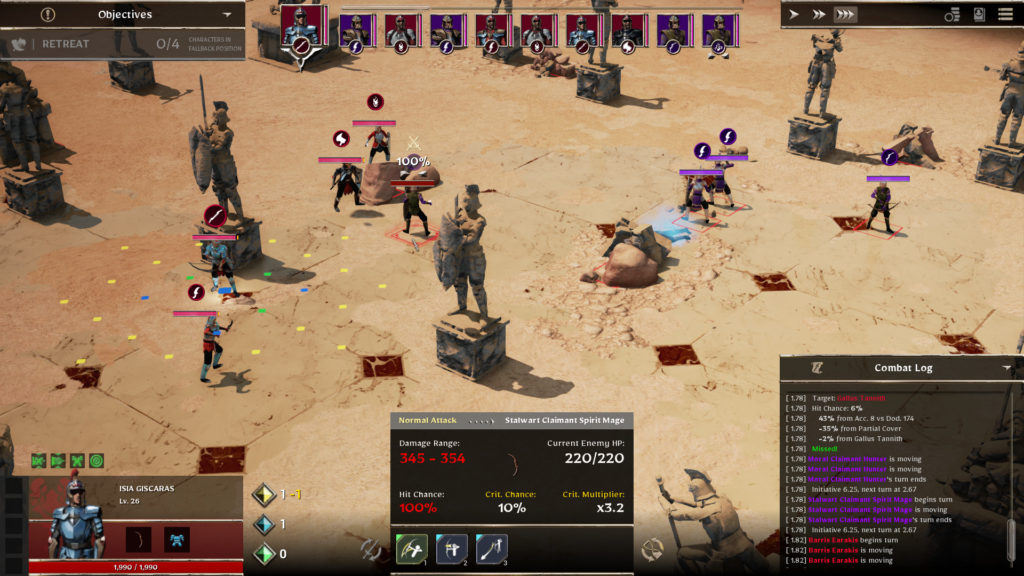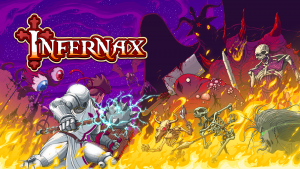
Forged of Blood is a fantasy title from indie developer Critical Forge, that blends turn based combat with a overarching kingdom management system. Critical Forge have taken tried and tested concepts, added complexity and some unique mechanics, and have created a deep and engaging, if slightly rough around the edges title.
The game in set in the world of Attiras, where you play through the perspective of Prince Tavias Caenican, younger brother to the heir of the throne. Tavias’ family are part of a humanoid race known as the Neshalan, a group who, for a long period of time, made up the ruling families of the continent. The story sets off with Tavias and his older brother, along with a small handful of companions, becoming refugees as the king is murdered in a racially-charged human rebellion. Through a combination of combat, diplomacy, and difficult choices, you act to regain the crown for your family. In this instance, having the player act as the second in line to the throne made a surprisingly significant impact in terms of how the story felt. It’s obvious that your character is significant, and would be given a great deal of responsibility. It is because of this power that the player may have to clash with the will of your older brother, who will actually take on the role of king, as well as your few remaining advisors, who rarely fully agree on anything.

Initially, you start off with your small party making your way across the map to safety. As well as serving the plot, this does a nice job of allowing you to get to grips with the combat and party management mechanics, before taking on kingdom responsibilities. Combat is easy to get to grips with, with each character having a swift (green), move (blue) and attack (yellow) action each turn. Some character abilities will use up one of these actions, such as using your move action to buff a character instead of moving it. The game also flags up certain markers, for example in an instance where you may trigger an attack of opportunity, or if moving a character will allow you to attack an enemy before you commit to the move. For me, there was some slight confusion about what my characters might be able to see from higher ground, with line of sight sometimes being cut off at strange angles. Whilst mechanically competent, the game does have a few sound and animation flaws during combat that somewhat mar the experience. In combat, character voice lines range from passable to poor, and characters do not have set voices attached to them (other than being male or female), so they may have one voice when their turn starts, and a different voice when you move or attack with them. There are even occasion where they would repeat the same line in two different tones, which feels, to put it lightly, a bit off-putting. The environments look good, but the character models could look a bit better, and the animations lack some fluidity. In contrast, the music during combat is, thankfully, excellent.
Forged of Blood prides itself on the scope of available tactical options, and it can certainly back up this claim. There are 9 weapon options, all with different skill trees. You also have the general skill tree, which contains options for things like mobility, resilience, and initiative, so you can design each party member exactly how you want them. It’s slightly daunting at first, especially with so many sub-stats like dodge, fortitude, hold and others to consider, but there is an auto-level option for each major branch in any given skill tree. The flexibility on offer is also a nice touch. You can completely re-spec any skill tree if you want to change your mind about your choices. Additionally, after any encounter, characters gain skill points with whatever weapons they brought into battle, including secondary weapons, even if they didn’t switch them out in combat. This allows you to keep your secondary role viable as you level up. I found that if I equipped a new type of weapon on a character, they would get a huge bonus in skill points after combat ended, which allowed me to always try new weapon options. The equipment management was poorer by comparison, as you would acquire tons of items after each fight, with only basic forms of inventory management to help keep everything in order. Keeping your gear and skills optimised between fights can be a chore, especially as you levelled up after each encounter, which in turn means checking your equipment for each surviving combatant.
The magurite spellcrafting system deserves a mention all of its own. Characters can acquire 3 different stone types which give access to different base spell effects, categorised as drain or expel. Once you have chosen a spell effect, you have a massive amount of customisation options for each spell, as long as you keep within your magurite control limit. You have a huge amount of choice here, including spell strength (fixed and variable), range, area in both length and width, duration, and several other factors. In a fight, you start at neutral charge, and casting either an expel or drain spell will shift this charge in that direction, meaning you have to cast the other type of spell next, in order to prevent spell spamming. Though it’s fun to customise spells, it could be a bit clearer how some of the effects would work with different base spell types.

Once you have a bit of time under your belt, you will gain access to the full map and kingdom management systems. From this point, battles, story quests, and other optional encounters will appear on the map, and you can move up to 3 parties, known as talons, wherever you wish to engage. Some quests will exist as part of taking over a region, whereas some will cause developments later in the game’s story. Although I haven’t yet played late enough into the game to see every choice unfold, it felt like there were a lot of things to do on the map, and the encounters were kept plot relevant enough to not make them feel like boring side activities designed to pad out play time. Whenever you made a choice about how to treat the people you encountered, it felt like each decision would affect how each of your companions saw you. As well as affecting individual encounters, your dialogue choices affect your personality plot point. Split between hedonism, altruism, and rationalism, your choices determine where you sit on an axis. Different regions on the map have their own philosophy, and although you may physically control a region, it’s way of thinking may cause the populace to support a different faction. Controlling a region will slowly bring their way of thinking in line with yours, but this takes time. Eventually, a conclave of lords will ask each region to choose who they wish to rule, and a region may elect to support a different faction to the one that controls it. This is a really nice feature, as it makes your choices in leadership style affect who may support you, as well as ensuring that you think about the wellbeing of people in addition to winning combat encounters.
Forged of Blood does a lot of things well. The mechanics, both within combat and outside of it, are solid, and whilst there may not be a huge amount of backstory or lore to discover, the plot is intriguing, and your choices will affect the surrounding characters. The game definitely has a few rough spots, namely in the sound design and character models, and the textures could be more impressive as well. Some patching would really be in order to make the equipment management more streamlined. However, these are minor blemishes in an otherwise deep and engaging fantasy title that gives you as much choice as anyone could reasonably expect. If you are a fan of turn based strategy, there’s a great deal to like here.
Score: 8.1/10







